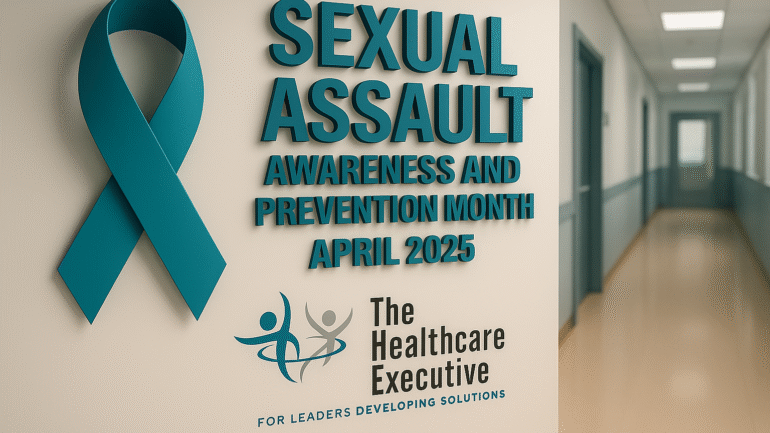Sexual Assault Awareness and Prevention Month – April 2025

- Posted by Greg Wahlstrom, MBA, HCM
- Posted in Health Observance Calendar
Leading Healthcare with Courage, Compassion, and Accountability
Published: April 1, 2025
Each April, healthcare leaders across the country observe Sexual Assault Awareness and Prevention Month (SAAPM) to bring attention to the pervasive and deeply harmful reality of sexual violence. In healthcare settings, survivors often seek care first—making it imperative that C-suite executives and clinicians alike understand the role of trauma-informed care. Sexual violence does not discriminate; it affects individuals of every gender, race, age, and background. While frontline staff are often trained to support survivors, system-wide protocols and executive-driven cultures of safety must follow. Leadership must move beyond compliance to ensure integrated support systems are implemented at every level. From emergency departments to outpatient clinics, a survivor’s first impression can shape the rest of their healing journey. Institutions that fail to adopt proactive strategies risk retraumatizing patients and eroding trust. According to the Rape, Abuse & Incest National Network (RAINN), someone in the U.S. is sexually assaulted every 68 seconds. With stakes this high, hospital CEOs and administrators have an obligation to act. Therefore, the month of April is not only about awareness—it’s about system accountability and executive transformation.
Healthcare organizations can no longer treat sexual assault response as a siloed initiative limited to emergency care or behavioral health units. A comprehensive model must include policy reform, staff education, facility redesign, and partnership with community advocates. For example, Sutter Health has built a Sexual Assault Response Team (SART) protocol that leverages emergency staff, trained advocates, and forensic experts across multiple campuses. This approach ensures consistency and sensitivity in high-stakes clinical encounters. In addition, administrative teams at Mount Sinai’s Center for Trauma-Informed Care have launched executive trainings to embed trauma literacy at the policy-making level. Too often, hospital executives underestimate how environmental factors—such as lighting, room layout, signage, or intake procedures—can affect the survivor experience. These factors should be evaluated regularly through a trauma-informed lens. Leaders must also consider culturally competent care, particularly for LGBTQIA+, disabled, and BIPOC survivors, who face higher rates of underreporting and systemic neglect. When leaders center survivor dignity and operationalize their response, they set a new bar for institutional integrity. Consequently, executives play a decisive role in creating climates of trust and repair.
Prevention efforts also deserve executive attention and measurable investment. It is no longer enough to react to incidents; healthcare systems must take responsibility for contributing to culture change. Educational initiatives such as SAFE’s Healthcare Education Programs train providers on consent-based language, body autonomy, and bystander intervention—concepts rarely covered in medical school. These programs can be expanded through continuing education credits and mandatory training protocols overseen by the Chief Medical Officer or Chief Learning Officer. Additionally, ChristianaCare’s Office of Health Equity and Violence Prevention offers community-based workshops and risk-reduction programming that actively involves patients and staff. This level of engagement fosters transparency and promotes health equity. By building an institutional culture that prioritizes prevention, healthcare leaders fulfill their moral, clinical, and fiduciary responsibilities. The cost of inaction is too high—both financially and in human lives. Thus, boards and senior executives must embed sexual assault prevention into quality metrics and annual performance reviews. Ultimately, this work must be seen as foundational to safety, not optional policy.
Equity and justice must be more than slogans—they must be structurally enabled by leadership. Institutions must have zero-tolerance policies that are enforced, clearly communicated, and supported by internal reporting channels that protect whistleblowers and survivors alike. Recent efforts by Boston Children’s Hospital’s REACH program have improved both patient and employee pathways for disclosing interpersonal violence. In addition, HR departments have partnered with clinical governance teams to ensure that workplace harassment protocols mirror patient protections. Across the board, hospital systems are beginning to reimagine what accountability looks like—beyond risk management. The executive suite must be deeply involved in these redesigns, ensuring cross-functional collaboration between quality, legal, HR, and clinical teams. Survivors cannot be expected to heal in environments where policies are reactive or performative. Only when leadership models transparency, timely action, and survivor-centered solutions can lasting cultural change take root. Hence, April should serve as both a mirror and a mandate for C-suite executives across healthcare. It is not a marketing campaign—it is a strategic imperative for ethical leadership.
To all healthcare leaders: this month is your call to action. Evaluate your systems, audit your policies, and ask your staff what support looks like. Let April 2025 mark a turning point in how institutions approach survivor care—not just in principle, but in practice. Whether you lead a community hospital or an academic medical center, your influence matters. Change begins when executives listen, lead with empathy, and back their values with policy and investment. The legacy of your leadership will be measured not by the absence of scandal, but by the presence of safety, trust, and advocacy. Let your organization be known not for its reaction, but for its readiness. Because prevention is leadership—and leadership begins at the top. Moving forward, let’s make sexual assault prevention an executive standard of care, year-round.
Discover More:
Learn how healthcare executives are redefining leadership through advocacy and safety-driven strategies by exploring this related post.



